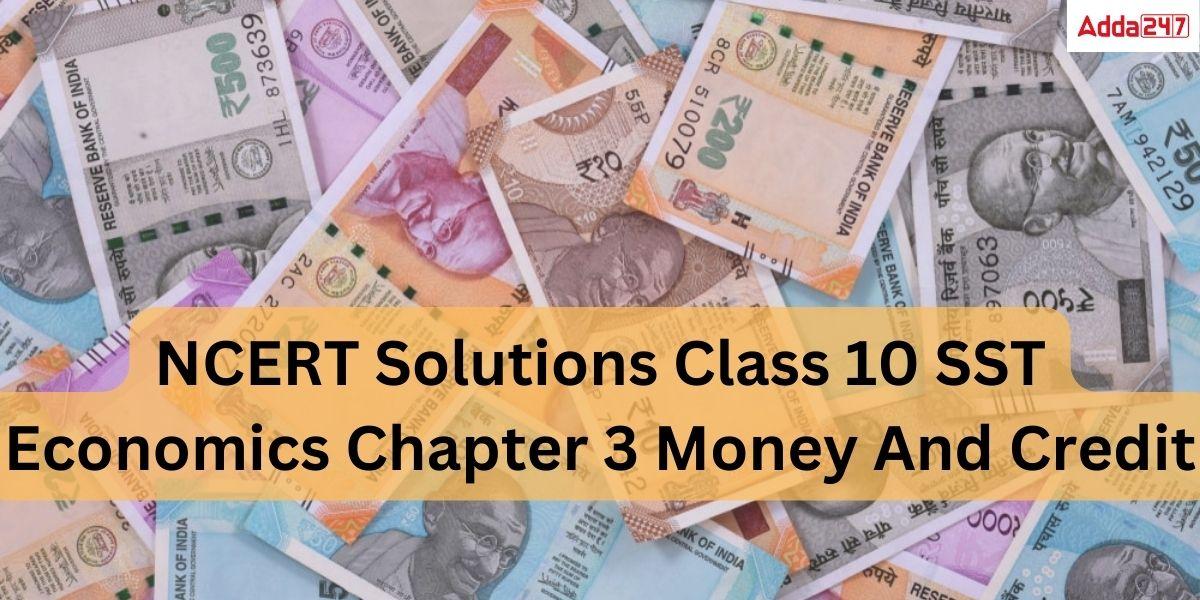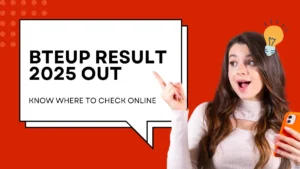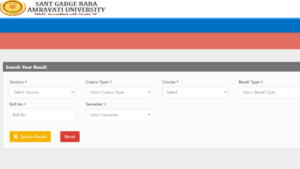NCERT Solutions Class 10 SST Economics Chapter 3 Money And Credit Notes
NCERT Solutions Class 10 SST Economics Chapter 3 Money And Credit notes are given in this article. NCERT Solutions Class 10 is the best resource for obtaining a good score in the class 10 board Examination. Here are Adda247 Expert faculty team prepared NCERT Solutions Class 10 SST Economics Chapter 3 Money And Credit exercises of that chapter for a better grasp of the topics. These NCERT Solutions answer all questions in an easy and simple manner. These solutions will help you understand the concepts covered in the chapter completely. By writing these answers in the exam students will undoubtedly be able to achieve high scores. Keep learning with Adda247.
Read: NCERT Solutions Class 10 SST Economics Chapter 4 Globalisation and the Indian Economy
NCERT Solutions Class 10 SST Economics Chapter 3 Money And Credit Pdf
NCERT Solutions Class 10 SST Economics Chapter 3 Money And Credit is given in pdf format so students can easily download it for future use. Click here to download NCERT Solutions Class 10 SST Economics Chapter 3 Money And Credit
Class 10 SST Economics Chapter 3 Money And Credit Video Explanation
Class 10 SST Economics Chapter 3 Money And Credit Summary
NCERT Solutions Class 10 SST Economics Chapter 3 Money And Credit: Two key aspects of the Indian economy are introduced in Class 10 SST Economics Chapter 3: Money and Credit. There are many ideas surrounding the act of lending money, sources of credit and the significance of credit for the growth of the nation’s credit situation, In this chapter, examples and case studies related to the development of the nation’s economy are provided, along with information on the official and informal lending sectors.
NCERT Solutions Class 10 SST Economics Chapter 3 Money And Credit Questions with Answers
1. In situations with high risks, credit might create further problems for the borrower. Explain.
Answer: In situations with high risks, credit might create further problems for the borrower. Taking credit includes a borrower borrowing money from a lender at a high interest rate . If the borrower is unable to repay the debt because of a loss in his work or business, he will slip even deeper into the loan trap. Another name for this is a debt trap. He is required to pay back the credit plus the lender’s interest. This makes things worse for the borrower. He is then compelled to turn over to the lender the collateral or asset that served as the guarantee.
2. How does money solve the problem of double coincidence of wants? Explain with an example of your own.
Answer: When things or commodities are exchanged without the use of money, a double coincidence of wants takes place. In this case, the people exchanging the products are truly in need of them. Double coincidence of wants is a key component of a barter system, in which items are directly traded without the need for money. Money eliminates the requirement for two demands to coincide and the problems with the barter system by acting as a means of exchange. No specific buyer or seller is needed any longer for goods exchange.
For instance, it would be challenging for a farmer to locate a market for veggies in exchange for seeds. But money will find a solution to this issue. The farmer can now sell his produce to a person in need and use the proceeds to buy seeds for himself.
3. How do banks mediate between those who have surplus money and those who need money?
Answer: Banks act as a mediator between individuals who have surplus funds (depositors) and those who need money (borrowers) by providing loans to those in need. Banks encourage people with extra money to invest it in their holdings. These people get paid in return at a particular interest rate. Banks allow customers to open accounts, and the banks utilize that money to fund customer loan requests. Using the majority of the deposits, they provide loans to borrowers who are in need. The borrower pays a higher interest rate, while the depositor receives interest for making deposits from that profit.
4. Look at a 10 rupee note. What is written on top? Can you explain this statement?
Answer: On the top of a 10 rupee note are the words “Reserve Bank of India” and “Guaranteed by the Government.” The Reserve Bank of India issues money in India on behalf of the national government. Therefore, these two claims indicate that the Central Government has approved or guaranteed the currency. This means that under Indian law, using this 10 rupee note as a form of payment is acceptable everywhere in the nation.
5. Why do we need to expand formal sources of credit in India?
Answer: The government-approved organizations that are permitted to lend money to people are termed formal sources of credit. In India, it is crucial to increase formal sources of credit because unregistered informal sources, which give money to individuals at high-interest rates, are unfair and shouldn’t be used. People will be able to borrow money at lower interest rates and use it to expand their businesses if there are more formal resources available. In the end, this will aid in the nation’s development.
6. What is the basic idea behind the SHGs for the poor? Explain in your own words.
Answer: Self Help Groups (SHGs) were founded in India with the aim of helping the underprivileged rural population. The primary idea behind self-help groups (SHGs) for the poor is to give them a financial resource by organizing rural poor people, particularly women, into tiny SHGs and pooling (collecting) their savings. Additionally, some organizations offer low-interest loans to their members without collateral during emergencies or other times of need. Therefore, increasing small-scale employment prospects for rural residents is the primary goal of SHGs.
7. What are the reasons why banks might not be willing to lend to certain borrowers?
Answer: Following are some explanations as to why banks might not be willing to give loans to specific borrowers:
- Banks want sufficient documentation and assets as loan security. Some people fall short of these standards.
- Banks may be less likely to lend to certain individuals because the likelihood that a loan would not be repaid increases with irregular income or lack of a set salary.
- The banks may not be willing to lend to borrowers who have not repaid prior loans. These borrowers are put on the list of NPAs.
- Banks could be reluctant to offer loans to business owners that plan to invest in high-risk ventures.
8. In what ways does the Reserve Bank of India supervise the functioning of banks? Why is this necessary?
Answer: The following are some of the functions that the Reserve Bank of India supervises bank operations:
- It keeps track of how well the banks are actually keeping the cash balance.
- It makes sure that banks lend money to small farmers, small-scale businesses, small borrowers, and other borrowers in addition to profitable companies and dealers.
- The quantity of loans made to people by other banks is reported on a recurring basis by the RBI.
- Banks are required to provide the RBI with information about their credit activities, including how much money they are lending to whom and at what interest rate.
9. Analyse the role of credit for development.
Answer: One of the key factors affecting a country’s development is credit. Credits are in great demand for a variety of economic activities.
- The economic situation of the poor can be improved if credit is made available to them under fair terms and conditions. This will aid in the development of the whole.
- Obtaining credit is essential to agricultural activity. With finance, farmers might apply contemporary farming techniques to boost crop productivity and cultivate crops that are more dependable than those grown using conventional techniques.
- The secondary sector’s activity could expand thanks to credit.By extending credit for people to start small businesses and industries. They could launch new businesses or engage in commerce. Credit is therefore essential to the prosperity of the nation.
10. Manav needs a loan to set up a small business. On what basis will Manav decide whether to borrow from the bank or the moneylender? Discuss.
Answer: The following terms of credit will be used by Manav to determine whether to borrow money from the bank or the moneylender:
- Comparison of the interest rates charged by the two sources.
- Requirements for collateral availability and supporting documents.
- Terms and Conditions
- Method of repayment.
11. In India, about 80 percent of farmers are small farmers, who need credit for cultivation.
a. Why might banks be unwilling to lend to small farmers?
Answer: As a result of the significant risks, banks might be reluctant to lend money to small farms. Before making loans, banks demand the right paperwork. Small farmers, however, might not be able to offer such documentation. Additionally, there is a chance that the small farmers will default on the loan if something happens to damage their crops.
b. What are the other sources from which the small farmers can borrow?
Answer: If small farmers aren’t taking out bank loans, they can turn to unofficial sources of finance. Local moneylenders, agricultural traders, large landlords, cooperatives, SHGs, and others are some of these informal sources of credit.
c. Explain with an example of how the terms of credit can be unfavorable for the small farmer.
Answer: The terms of credit become unfavorable for the small farmers because If a farmer takes out a bank loan and his crops are destroyed during harvest,. Small farmers find it impossible to repay the debt by selling their crops in the event of crop failure. Therefore, the small farmers sell a portion of their land to pay back the loan. Small farmers occasionally provide security or collateral for loans. Typically, the collateral consists of real estate, structures, automobiles, and animals. If a loan is not repaid, the lender may sell the collateral to recoup its loss.
d. Suggest some ways by which small farmers can get cheap credit.
Answer: Small farmers can obtain cheap credit from a variety of institutions, including banks, agricultural cooperatives, and SHGs.
12. Fill in the blanks:
- Majority of the credit needs of the _________________households are met from informal sources.
- ___________________costs of borrowing increase the debt-burden.
- __________________ issues currency notes on behalf of the Central Government.
- Banks charge a higher interest rate on loans than what they offer on __________.
- _______________ is an asset that the borrower owns and uses as a guarantee until the loan is repaid to the lender.
Answer a: poor
Answer b: high
Answer c: Reserve Bank of India
Answer d: deposits
Answer e: collateral
13. Choose the most appropriate answer.
- In an SHG, most of the decisions regarding savings and loan activities are taken by
-
- Bank.
- Members.
- Non-government organization.
-
Answer: b. Members
2. Formal sources of credit do not include
-
-
- Banks.
- Cooperatives.
- Employers.
-
Answer: c. Employers
Found this article helpful?
Let’s connect via chat or call our senior expert counselor at +91-9625869989 to learn more about the different streams and options available. We would love it if we could add some of your insights. If you have a definite goal of scoring the highest marks, then you can resolve your doubts via our app (https://play.google.com/store/apps/details?id=com.adda247.app&referrer=invite_code=8973023) and youtube class assistance (https://www.youtube.com/c/Adda247School)
NCERT Solutions Class 10 SST Economics Chapter 3 Money And Credit-FAQs
Q.How do I acquire the NCERT Solutions for Class 10 SST Economics Chapter 3 Money And Credit in an online PDF format?
Ans. you can download the NCERT Solutions for Class 10 SST Economics Chapter 3 Money And Credit PDF from the link provided in the article.
Q.How can using NCERT Solutions for Adda247’s Economics Chapter 3 for Class 10 SST benefit you?
Ans. The following are some benefits of using Adda247’s NCERT Solutions for Class 10 SST Economics:
- Students are given both the NCERT solution and a video explanation.
- A PDF is also provided, which can be downloaded and saved for future use.









 BTEUP Result 2025 Out at bteup.ac.in, Do...
BTEUP Result 2025 Out at bteup.ac.in, Do...
 SGBAU Result 2025 Out, Check Summer Seme...
SGBAU Result 2025 Out, Check Summer Seme...
 How To Prepare for CUET Accountancy Exam...
How To Prepare for CUET Accountancy Exam...









